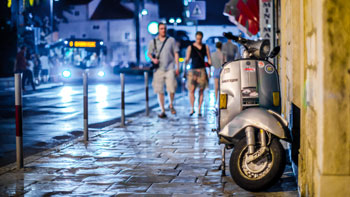







feedback: get some shots where half the face is showing








feedback: get some shots where half the face is showing


When doing neon lighting, something I need to consider is the contrasting colors. I really liked the orange and purple because they contrasted, but also blended together nicely because they were complementary colors. What I also liked more is that the orange was more on the face than the purple. The orange and the color of my skin are analogous colors, and so with the purple and black. The colors really do highlight the texture, I do like how the purple light looked on my hair on the first image, it gives it a shine.
In my future photographs, I want to keep the lighting in mind and where it comes from. Because my sets might be more monocolored and higher contrast, I need to keep in mind how the light might look when boosted.
(work in progress)
The Title of this project is….
A social aspect I want to explore is how each of our identities are also built up from the friends we choose to keep around. I want my audience to see these people how I see them, through a lens that only I could really understand because it’s mine. My perception of somebody is made up from all the experiences and memories I carry of them. A mask of a drawing I made specifically for them. I don’t want my audience to assume or make judgement of who they might be, but what I value in my friends.
I will get inspirations from looking at cartoons, a style that might match them as a person, a lot of them have things called shape language. Shape language tells a lot about a person, if they’re boxy and strong, or round and sweet. I also want to make sure the person has interesting texture or visual aspect. I want my subject to pose but not stiff. Another part of my vision is black and white coloring, to hopefully make the face pop out more. To add texture and visual effect, I want it to look like a scrapbook. With stickers or written statements from me, to make (fake) annotations like I’m writing a letter to them. Something I hope to get to is to print the photos on actual photo like frames and replicate making a photo book.

I didn’t mean to, but I did like the texture of my outfit. my jacket had white jewels on them and they showed up too. I also had a white star necklace on too. it looks cool and made my figure more interesting in motion. This is something I do want to take away, I do enjoy the disruption the white details gave.


These two photos are really similar, but something I like in the first photo more than the second one was the lighting and also the how blurred the faces are. The blog does decrease the quality, but the first photo blurs the face more. The shutter time was longer, so there’s prone to be more movement in the face. The lighting is also vastly different, which I’m assuming is also the shutter time. We didn’t change the light’s brightness at all during this part of the shoot, so I think maybe the longer the shutter time, the brighter it is.
A photo I didn’t put up but you can see the trend in these photos, I realized that black probably shows up with more detail than not. I was the only one with bangs and my face was usually much more clear, even with short shutter time.
For my identity project, I want to focus on the fact that you pass by millions of people everyday. I want my project to focus on the lack of identity instead of hyper focusing on the person’s details. To have an identity with little known features. I want my person to be wearing headphones or something that is identifiable, but to have something covering his face at the same time. The idea that you would see millions of faces, but only know them shallowly and just by their faces or what you presume of them.
My vision was mostly inspired by the Mask Series by Igne Morath. I really like the visual of the paper bags over their faces, the look of the paper bags are abstract and really expressive. The identity or the looks of the person is over exaggerated or maybe even up to the viewer’s interpretation. Something I also want to look into is the patterns of their clothes. This series is mainly in monochrome and what seems to be of a higher contrast. The textures of the clothes really pop and give the character a personality, especially with the poses being so stiff, you really can scan over the person’s outfit and the texture of it. They suggest a certain part of their identity without saying it. One of my favorites might be the cheetah print one. The mask is boxy, the cheetah print had been linked to strong feminine power for a while, the bag is a statement of the outfit, the way she’s standing with her arms crossed gives her a sense of defiance. It gives a very sharp, powerful, and strong identity, but also reminds us that this is almost like a character because of the absurdity of the mask. This is something I’m a fan of. These images tell a lot more through the environments and outfits the subjects are put in rather than the face, despite their exaggerations. It’s satisfying to me, as it shows the person is more character than they might let on.
Things I want to focus on/remember…


 3*
3*
“Inge Morath – Untitled. (From the Mask Series With Saul Steinberg), 1962. Photograph by Inge Morath/MAGNUM PHOTOS. Mask by Saul Steinberg © the Saul Steinberg Foundation/ARS, NY.” Barbara Picci, 2 Dec. 2019, barbarapicci.com/2019/12/03/inge-morath-museo-di-roma-in-trastevere/inge-morath-untitled-from-the-mask-series-with-saul-steinberg.
“Group Portrait With Masks (From the Mask Series With Saul Steinberg), 1962 – Saul Steinberg Foundation.” Saul Steinberg Foundation, 13 June 2024, saulsteinbergfoundation.org/artwork/group-portrait-with-masks-from-the-mask-series-with-saul-steinberg-1962.
3* the photo is from the DX powerpoint, P1 07 – Identity – Portraits 01 – Connect – Visions and Inspiration, slide 41.

A photograph is a portrait when you capture somebody or something, often connecting to an issue that the photographer or a common issue people face in life. A selfie can be a portrait, a self-portrait, but majority of the time it doesn’t depict anything. That issue, essence, or story is what makes a portrait good, it makes it interesting or highlights a certain part of the human body. There’s many types of portraits for all different reasons. From a blog of a portrait photographer, they say that the difference is the intent. While they both capture a subject, but a photograph captures the certain moment in time rather than personality. Portraits takes up a lot of time, considering the subject’s lightening, composition, color, and the overall mood/personality it would give. What makes a portrait better than another is the amount of detail and the planning you can visibly think. What makes a professional glamour portrait more advanced is the lightening and the setting compared to the casual mirror picture (which could be a photograph rather than a portrait).`
An abstract representation can be more-so capturing the essence of the person rather than the finer details. to provide a message that is more deeper than the human body. Or a collage of faces stitched together can document the family the deeper bound between both subjects. The example below is the ties of an older guardian and a younger kid in the same family tree.

(Family Tree by Bobby Neel Adams)
Lastly, I believe a still-life of just objects can technically be a portrait. With careful arrangement and shows a certain story behind a person or people, it can be a portrait (some might just be more shallow than the others).
Alextaylorphotography. “Portraits Without a Person.” Alex Taylor Photography, 5 Mar. 2015, alexjtaylorphotography.wordpress.com/2015/03/05/portraits-without-a-person.
DeGuzman, Kyle. “What Is Portrait Photography — Types, Styles, Concepts &Amp; More.” StudioBinder, 3 June 2025, www.studiobinder.com/blog/what-is-portrait-photography-definition.
Anthony, Michael. “What Is the Difference Between Portraits and Photographs?” My Canvas Portraits, 27 Mar. 2024, www.mycanvasportraits.com/post/what-is-the-difference-between-portraits-and-photographs.
“FamilyTree | Site.” Site, www.bobbyneeladams.com/familytree.



Shopkeeprs
better quality images -> street photography final photos
Reflection
in my photos, after a lot of editing, I like how the vibrance and the colors came out. It wasn’t exactly my reference or what I was going for, but I like it none the less. I was just glad could capture some of these buildings and the life they carry behind them.While my angles weren’t as precise as Sally’s (the artist I took inspiration off of) there are a few that I am proud of. I’m also really proud of how the warm tones and the cool tones came out. Some of the photos, the cool tones were a lot stronger compared to the warmer tones, and vice versa. The shops here were full of different items and colors, which really gave many complex and interesting shapes in my photographs. I must admit, my photos were a lot more vibrant than what I first imagined it!
In these photos, I’m proud of what I could capture. All of these photos have the aspect of buying or selling, the act of engaging with the local services. It gives the photos life and conversation in the first place. The coziness but also boredom these workers have in their day to day life. The decorations they thought would look good in their storefront. That’s what I’m proud of capturing.





I would love tips to know where I should import these photos in better quality.
Here you can showcase the x number of Featured Content. You can edit this Headline, Subheadline and Feaured Content from "Appearance -> Customize -> Featured Content Options".

Central Park is is the most visited urban park in the United States as well as one of the most filmed locations in the world. It was opened in 1857 and is expanded in 843 acres of city-owned land.

It might be work, but it doesn't have to feel like it. All you need is a comfortable desk, nice laptop, home office furniture that keeps things organized, and the right lighting for the job.

The Vespa Scooter has evolved from a single model motor scooter manufactured in the year 1946 by Piaggio & Co. S.p.A. of Pontedera, Italy-to a full line of scooters, today owned by Piaggio.